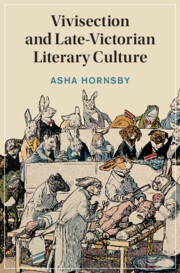Book contents
- Vivisection and Late-Victorian Literary Culture
- Cambridge studies in nineteenth-century Literature and culture
- Vivisection and Late-Victorian Literary Culture
- Copyright page
- Dedication
- Contents
- Figures
- Acknowledgements
- Abbreviations
- Introduction
- Part I Protest
- Part II Reading Vivisectors
- Part III Representing Pain
- Part IV Writing as Vivisection
- Conclusion
- Notes
- Bibliography
- Index
- Cambridge Studies in Nineteenth-Century Literature and Culture
Introduction
Published online by Cambridge University Press: 30 January 2025
- Vivisection and Late-Victorian Literary Culture
- Cambridge studies in nineteenth-century Literature and culture
- Vivisection and Late-Victorian Literary Culture
- Copyright page
- Dedication
- Contents
- Figures
- Acknowledgements
- Abbreviations
- Introduction
- Part I Protest
- Part II Reading Vivisectors
- Part III Representing Pain
- Part IV Writing as Vivisection
- Conclusion
- Notes
- Bibliography
- Index
- Cambridge Studies in Nineteenth-Century Literature and Culture
Summary
Following a brief historical overview of the birth of the organised movement, Chapter 1 introduces literary figures and texts promoted by antivivisection periodicals such as the Zoophilist, the Home Chronicler, and the Animals Guardian. Adopting a literary-critical approach offers a fresh perspective on the movement’s association pamphlets and periodicals which have, thus far, largely been examined as historical documents. Poems, stories, and ‘humane words’ from notable writers were sourced and deployed to shape a common antivivisectionist identity, articulate the movement’s ideology, and mobilise activists. Analysis of antivivisection poems by Christina Rossetti, Robert Browning, Alfred Tennyson, and Robert Buchanan is complemented by attention to the framing and reception of these works in antivivisection publications and the wider press.
Keywords
- Type
- Chapter
- Information
- Vivisection and Late-Victorian Literary Culture , pp. 1 - 20Publisher: Cambridge University PressPrint publication year: 2025

